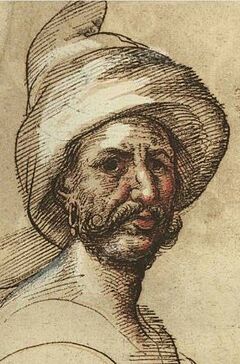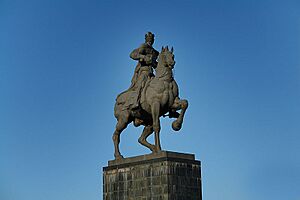Giorgi Saakadze facts for kids
Quick facts for kids
Grand Mouravi
Giorgi Saakadze |
|
|---|---|

Saakadze's portrait drawn by Teramo Castelli in Constantinople, Ottoman Empire in 1626.
|
|
| Native name |
გიორგი სააკაძე
|
| Nickname(s) | Grand Mouravi |
| Born | c. 1570 Peli, Kingdom of Kartli |
| Died | October 3, 1629 Aleppo, Ottoman Empire |
| Allegiance | Kingdom of Kartli Kingdom of Kakheti Safavid Persia Ottoman Empire |
| Battles/wars | Battle of Tashiskari Battle of Marabda Battle of Martqopi Battle of Bazaleti Ottoman–Safavid War (1623–1639)
|
Giorgi Saakadze (Georgian: გიორგი სააკაძე; born around 1570 – died October 3, 1629) was a famous Georgian leader. He was both a politician and a military commander. Giorgi Saakadze played a very important role in Georgia's history in the early 1600s.
He was also known as the Grand Mouravi (დიდი მოურავი). A mouravi was a special royal official, like a manager or a governor. Giorgi Saakadze served as the mouravi of Tbilisi, the capital city.
Contents
Who Was Giorgi Saakadze?
Early Life and Rise to Power
Giorgi Saakadze was born around 1570. His family came from the lower nobility in Georgia. His father, Siaush, worked for King Simon I of Kartli. Giorgi started his military career serving this king.
Later, under the young King Luarsab II, Giorgi became a mouravi in 1608. He was in charge of Tbilisi and other areas. His power grew a lot after a big victory.
Saving the King: Battle of Tashiskari
In June 1609, Giorgi Saakadze defeated an army from the Ottoman Empire. This battle was called the Battle of Tashiskari. His victory saved King Luarsab II from being removed from power.
In 1611, King Luarsab married Giorgi's sister, Makrine. This made the powerful noble families upset. They were suspicious of Giorgi, who had become very influential. The nobles thought Giorgi was working for Iran. They convinced King Luarsab to divorce Makrine and planned to harm Giorgi in May 1612.
Giorgi escaped and went to Iran. He became a Muslim and showed his great military skills in Iran's wars. This helped him gain the trust of Shah Abbas I of Iran, the ruler of Iran.
Fighting for Georgia's Freedom
Return to Georgia and New Role
In 1614, Giorgi Saakadze helped Shah Abbas invade Georgia. This ended King Luarsab's rule. But Giorgi convinced the Iranians not to harm the people of Kartli after they surrendered.
In 1619, the Shah made Giorgi a "vekil," which means a regent or a temporary ruler, for Bagrat Khan. Bagrat was the Shah's choice for the throne of Kartli. This made Giorgi the real ruler of Kartli.
Leading Battles Against Invaders
From 1621 to 1623, Giorgi Saakadze was a top commander for Shah Abbas. He fought bravely against the Ottomans. Because of his military success, the Shah put him in charge of a large army. This army was sent to stop a rebellion in Georgia.
Giorgi then found out that the Shah planned to kill all armed Georgians, including him. So, he secretly joined the Georgian rebel leaders. These leaders included his brother-in-law Zurab of Aragvi and King Teimuraz I of Kakheti.
On March 25, 1625, Giorgi and the rebels surprised the Iranian army at the Battle of Martqopi. They won a huge victory. Giorgi then drove out the Iranian governor from Kakheti. He also attacked Iranian military bases far away.
In revenge, Shah Abbas had Giorgi's younger son, Paata, killed. After this, another Iranian army attacked Georgia. They won a difficult victory over the Georgians at the Battle of Marabda. Giorgi Saakadze and his forces went into the mountains. They started a strong guerrilla fight. This forced Shah Abbas to accept Teimuraz as the rightful king of Georgia.
Exile and Final Days
Conflict Among Georgian Nobles
However, the Georgian nobles soon started fighting among themselves. Giorgi Saakadze disagreed with King Teimuraz's control over Kartli. This led to a sad battle between Georgians, called the Battle of Bazaleti, in late 1626.
King Teimuraz's army won this battle. Giorgi Saakadze had to leave Georgia. He went to Constantinople, the capital of the Ottoman Empire. There, he started working for Sultan Ibrahim I.
He briefly served as a governor in the Konya region. He also fought against the Iranians in 1627-1628. But soon, the Grand Vizier (a high official) accused Giorgi of working against the Sultan.
On October 3, 1629, Giorgi Saakadze was killed in Constantinople. His son Avtandil and other Georgians were also killed.
Giorgi's last surviving son, Ioram, later became a prince in Georgia. He started the Tarkhan-Mouravi noble family.
Giorgi Saakadze in Culture

Giorgi Saakadze's life has always been seen in different ways. Some historians thought he was just an ambitious warrior. They saw him as someone who caused trouble in Georgia's history.
But some people tried to show his good side. A poem called The Grand Mouravi was written about him in the late 1600s. In the 20th century, some Georgian writers highlighted his role in the 1625 rebellion. This rebellion stopped Shah Abbas's plan to change eastern Georgia.
During World War II, Joseph Stalin used Giorgi Saakadze as a symbol of Georgian patriotism. Stalin said that Giorgi's goal to unite Georgia was a good idea. Stalin even helped change the script for a movie about Giorgi Saakadze. The movie, called Giorgi Saakadze, was made in 1942-1943.
The film showed Giorgi as a simple man who was a victim of rich nobles. It showed him as a hero who fought against invaders. The movie also taught that betraying a leader, and thus the country, was a serious crime.
Images for kids
See also
 In Spanish: Giorgi Saakadze para niños
In Spanish: Giorgi Saakadze para niños


